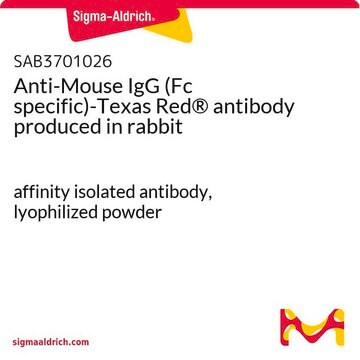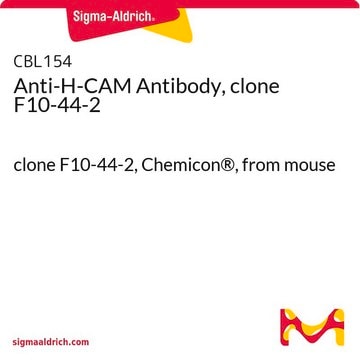C0678
Monoclonal Anti-HNK-1/N-CAM (CD57) antibody produced in mouse
clone VC1.1, ascites fluid, buffered aqueous solution
Sinonimo/i:
Monoclonal Anti-HNK-1, Anti-CD57, Anti-N-CAM
About This Item
Prodotti consigliati
Origine biologica
mouse
Coniugato
unconjugated
Forma dell’anticorpo
ascites fluid
Tipo di anticorpo
primary antibodies
Clone
VC1.1, monoclonal
Forma fisica
buffered aqueous solution
contiene
15 mM sodium azide
Reattività contro le specie
mouse, rat, feline, human
tecniche
western blot: 1:4,000 using cerebral cortex extract
Isotipo
IgM
N° accesso UniProt
Condizioni di spedizione
dry ice
Temperatura di conservazione
−20°C
modifica post-traduzionali bersaglio
unmodified
Informazioni sul gene
human ... B3GAT1(27087)
mouse ... B3gat1(76898)
rat ... B3gat1(117108)
Cerchi prodotti simili? Visita Guida al confronto tra prodotti
Descrizione generale
Specificità
5th Workshop: code no. NK 67
Immunogeno
Applicazioni
Immunohistochemistry (1 paper)
- as primary antibody for western blot analysis
- immunocytochemistry
- immunocytochemical
- immunohistological staining
Azioni biochim/fisiol
Descrizione del bersaglio
Esclusione di responsabilità
Not finding the right product?
Try our Motore di ricerca dei prodotti.
Codice della classe di stoccaggio
10 - Combustible liquids
Classe di pericolosità dell'acqua (WGK)
WGK 3
Punto d’infiammabilità (°F)
Not applicable
Punto d’infiammabilità (°C)
Not applicable
Certificati d'analisi (COA)
Cerca il Certificati d'analisi (COA) digitando il numero di lotto/batch corrispondente. I numeri di lotto o di batch sono stampati sull'etichetta dei prodotti dopo la parola ‘Lotto’ o ‘Batch’.
Possiedi già questo prodotto?
I documenti relativi ai prodotti acquistati recentemente sono disponibili nell’Archivio dei documenti.
Il team dei nostri ricercatori vanta grande esperienza in tutte le aree della ricerca quali Life Science, scienza dei materiali, sintesi chimica, cromatografia, discipline analitiche, ecc..
Contatta l'Assistenza Tecnica.








